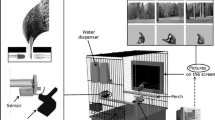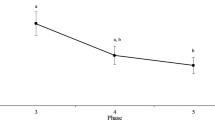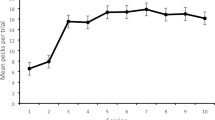Abstract
Operant key pecking was assessed in eight adult male Japanese quail (Coturnix coturnix japonica). Subjects could peck either of two response keys to obtain bird chow reinforcement. In addition, one of the keys controlled visual exposure to conspecifics by altering illumination in a companion compartment adjacent to the subject. One, two, or no companion quail were present. Pecks on the “companion” key started or maintained exposure to companions. Results indicated that (a) subjects reduced significantly the frequency of pecks maintaining companion exposure when companion quail were actually present, (b) cumulative duration of exposure to companions was significantly lower when companions were present, and (c) the overall rate of key pecking was inhibited significantly during exposure to companions. These data contribute to the establishment of a mediating link between observed social inhibition of food-reinforced key pecking and apparent lack of subject preference for visual exposure to conspecifics during operant testing.
Similar content being viewed by others
References
CHEREK, D. R., & PICKENS, R. 1970. Schedule-induced aggression as a function of fixed-ratio value. Journal of the Experimental Analysis of Behavior, 14, 309–311.
CHEREK, D. R., THOMPSON, T., & HEISTAD, G. T. 1973. Responding maintained by the opportunity to attack during an interval food reinforcement schedule. Journal of the Experimental Analysis of Behavior, 19, 113–123.
DENI, R. 1977a. Inhibition of operant responding in Japanese quail during visual exposure to a companion. Perceptual and Motor Skills, 44, 251–257.
DENI, R. 1977b. Duration of exposures to a conspecific and social inhibition of operant behavior in Japanese quail. Psychological Reports, 41, 63–70.
DENI, R. 1978. Social influences on operant behavior in Japanese quail: Sex differences among subjects, and sex and age differences among companions. The Psychological Record, 28, 95–108.
FLORY, R. 1969. Attack behavior as a function of minimum inter-food interval. Journal of the Experimental Analysis of Behavior, 12, 825–828.
GENTRY, W. D. 1968. Fixed-ratio schedule-induced aggression. Journal of the Experimental Analysis of Behavior, 11, 813–817.
LINTON, M., & GALLO, P. S. 1975. The practical statistician: Simplified handbook of statistics. Belmont, Ca.: Brooks-Cole.
THOMPSON, T. 1964. Visual reinforcement in fighting cocks. Journal of the Experimental Analysis of Behavior, 7, 45–49.
WEISS, R. F., & MILLER, F. G. 1971. The drive theory of social facilitation. Psychological Review, 78, 44–57.
Author information
Authors and Affiliations
Additional information
This research was supported by NICHD Grant No. 00973.
Rights and permissions
About this article
Cite this article
Deni, R. Response-Contingent Visual Exposure to Conspecific and Social Influence on Key Pecking in Japanese Quail. Psychol Rec 28, 375–382 (1978). https://doi.org/10.1007/BF03394549
Published:
Issue Date:
DOI: https://doi.org/10.1007/BF03394549




